Cornelis de Wael
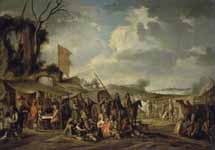
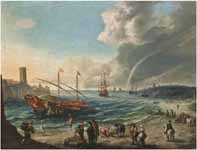
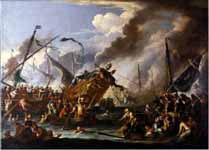
Battle between Christians and Turks
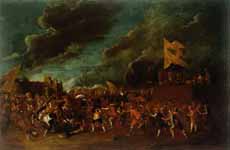
Battle against a fortified city
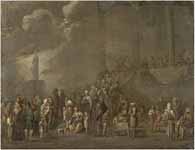

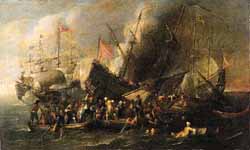
Naval battle between Turks and Christians


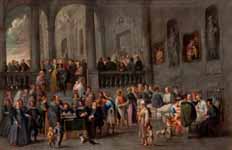
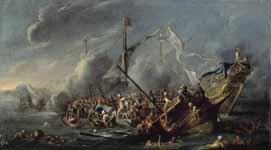
Naval battle between Spanish and Turks
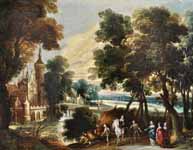
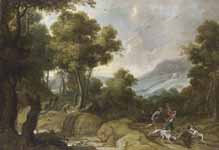
A forest landscape with hunters and their dogs attacking a wolf


Cornelis de Wael (Antwerp, 1592 – Rome, 1667) was a Flemish painter, engraver and merchant who was primarily active in Genoa in Italy. He is known for his genre paintings, battle scenes and history paintings. Through his art work, support for Flemish painters working in Italy and role as an art dealer, he played an important role in the artistic exchange between Italy and Flanders in the first half of the 17th century.
Life
Naval battle between the Spanish and Turks
Cornelis de Wael was born into an artistic family in Antwerp as the son of the painter Jan de Wael I (1558-1633). His mother Gertrude de Jode came from a family of artists: her father was the cartographer Gerard de Jode and her brother was the engraver Peter de Jode I.
He immigrated in 1619 to Italy, together with his brother Lucas de Wael (1591-1661), who was also a painter. The pair settled in Genoa, where Cornelis would reside for most of his life, whereas his brother Lucas returned to Antwerp in 1628.[1][2] Genoa was at the time an attractive destination for artists since the competition between artists there was less intense than in the leading cultural centres Rome, Florence and Venice, while Genoa was a thriving port city where a large number of potential customers and collectors lived.[3]
The workshop of the brothers de Wael in Genoa became the centre of the colony of Flemish artists who resided in or passed through the city. These Flemish artists could take advantage of the work and artistic activity that their workshop attracted. The brothers provided a home, materials and tools, they assisted their compatriots with their local integration, passed on recommendations to clients and formulated competition rules. When Anthony van Dyck visited Genoa, he stayed with the brothers and Cornelis was one of his closest collaborators in the city.[4] Van Dyck painted a portrait of the brothers de Wael (Pinacoteca Capitolina, Rome) that was later engraved by Wenceslaus Hollar. Cornelis was also involved in trading activities with his hometown dealing in a wide variety of goods. His brother Lucas returned to Antwerp and played a major role in these business activities.[2]
He also spent time in Rome where he came into contact with the members of the Bentvueghels, an association of mainly Dutch and Flemish artists working in Rome. In 1627 he became a member of the Accademia di San Luca, the prestigious association of artists in Rome which had very strict admission criteria. He settled permanently in Rome around the year 1656 to avoid an outbreak of the plague in Genoa.[2] Here he continued to paint and trade. From 1664 to 1666 he was prior of the congregation of San Giuliano dei Fiamminghi, which assisted Flemish residents of Rome.[5]
There was a great demand for the work of Cornelis de Wael. His patrons included the rich patricians of the Government of the Republic of Genoa as well as Philip III of Spain and Philippe-Charles, 3rd Count of Arenberg.[6]
Cornelis de Wael’s pupils included his cousin Jan Baptist de Wael (the son of Lucas), the Flemish painter Jan Hovaert (also known as Giovanni Hovart, Giovanni di Lamberto, Giovannino del su Lamberto, Jan Lambertsz Houwaert) and Antonio Rinaldi.[7][8]
Work
A camp by the ruins
De Wael was a versatile artist who produced etchings, paintings and drawings and may even have designed tapestries. De Wael worked in the most diverse genres.[6] His work can be divided along two main lines: the works in the so-called "grand manner", which were not shown to the general public and the works in the "small manner". The latter were of medium, small and very small size and were populated by a large number of figures and show the influence of the Flemish painting tradition and the genre paintings of the ‘Bamboccianti’. The Bamboccianti were a loose group of principally Dutch and Flemish genre painters residing in Rome who took the everyday life of the lower classes in Rome and its countryside as the preferred subject of their paintings. He also painted religious works, such as the series of paintings on the theme of the Seven works of mercy'.[9]
The early Dutch biographer Arnold Houbraken reported that Cornelis de Wael was specialized in battle scenes. A number of these paintings depicting battles on land (such as the Siege of Ostend, in the Museo del Prado) and sea (such as the "Battle between Christians and Turks", in the Museo Poldi Pezzoli) have survived. The broad composition of some of his military works is close to that of Pieter Meulener and Adam Frans van der Meulen while their static quality recalls the work of Sebastiaen Vrancx.[6]
He collaborated with van Dyck as well as with other Flemish artists such as the landscape painter Jan Wildens.[10] Collaborations with local artists were also frequent. De Wael or someone from his circle painted the staffage in the landscapes of the Italian landscape painter Giovanni Battista Vicino.[4][6]
In many of his battle scenes and harbour views his brother Lucas painted the landscapes while Cornelis in turn added the figures to Lucas' paintings.[11]
He also left many drawings some of which are part of collection of the Louvre and the British Museum. The British Museum holds an album of 53 drawings dating from 1640-1650 which covers mainly military subjects.[12] These drawings are generally more direct and are often signed or inscribed.[6]
It is difficult to trace the evolution in his painting style since only one signed work of his has survived. On the other hand, a number of signed or inscribed drawings have been preserved.[6]
References
Visiting the sick
Kornelis de Waal biography in: Arnold Houbraken, De groote schouburgh der Nederlantsche konstschilders en schilderessen (1718) (Dutch)
Lucas and Cornelis de Wael: Flemish artists and dealers in Antwerp, Genoa and Rome in the seventeenth century
Anversa & Genova: een hoogtepunt in de barokschilderkunst (Dutch)
Wael, Cornelis in: the Enciclopedia online of the Prado Museum (Spanish)
Pauline Rebel, De Vlaamse kunstenaar in het 17e -eeuwse Rome, Beschrijving van de economische, sociale en historische context, augustus 2010 (Dutch)
Jetty E. van der Sterre. "Cornelis de Wael Grove Art Online. Oxford Art Online. Oxford University Press. Web. 21 Feb. 2014
Cornelis de Wael at the Netherlands Institute for Art History (Dutch)
Raffael Soprani, Vite de' pittori, scultori ed architetti, Stamp. Casamara, 1768, p. 465-466 (Italian)
A. Stoesser-Johnston, 'Save my soul / save my image; The seven works of mercy by Cornelis de Wael', Desipientia 7 (2000), nr. 1, p. 47-56
About Cornelis de Wael at Jean Moust
Jetty E. van der Sterre. "Lucas de Wael. Grove Art Online. Oxford Art Online. Oxford University Press. Web. 26 May 2014
Frontispiece of the album of drawings at the British Museum
Further reading
Di Fabio, Clario, 'Dai Van Deynen ai De Wael. I Fiamminghi a Genova nella prima metà del Seicento', in: Pittura fiamminga in Liguria. Secoli XIV - XVII', a cura di P. Boccardo e C. Di Fabio, Milano 1997, pp. 202 – 227
Di Fabio, Clario, 'Due generazioni di pittori fiamminghi a Genova (1602-1657) e la bottega di Cornelis de Wael', in: Van Dyck a Genova. Grande pittura e collezionismo, cat. mostra di Genova (22 marzo - 13 luglio 1997) a cura di S.J. Barnes, P. Boccardo, C. Di Fabio, L. Tagliaferro, Milano 1997, pp. 82–104
Stoesser-Johnston, Alison Mary, Lucas and Cornelis de Wael: Flemish Artists and Dealers in Antwerp, Genoa, and Rome in the Seventeenth Century, Brepols, 2012
----
Fine Art Prints | Greeting Cards | Phone Cases | Lifestyle | Face Masks | Men's , Women' Apparel | Home Decor | jigsaw puzzles | Notebooks | Tapestries | ...
----
A - B - C - D - E - F - G - H - I - J - K - L - M -
N - O - P - Q - R - S - T - U - V - W - X - Y - Z
Retrieved from "http://en.wikipedia.org/"
All text is available under the terms of the GNU Free Documentation License


